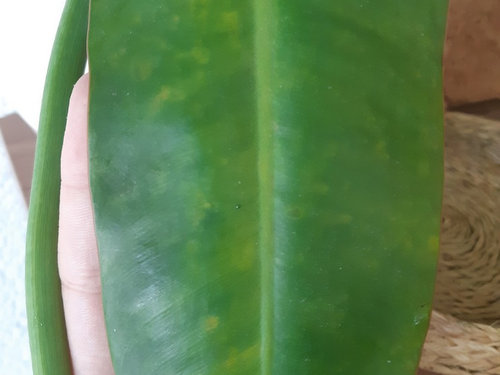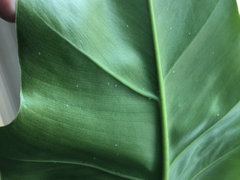Yellow spots on Philodendron and droplets :help?
Naak Goods
6 years ago
Featured Answer
Sort by:Oldest
Comments (25)
laticauda
6 years agolast modified: 6 years agopetrushka (7b)
6 years agolast modified: 6 years agoRelated Discussions
Split leaf philodendron leaves yellowing and falling off??
Comments (7)This is actually how large Aroids grow. Aerial roots grow in the crease between the oldest leaf and the stem. When the plant becomes taller (or longer, I should say) this will become more evident. The oldest, tiniest leaves naturally yellow and die, however I find this takes longer for M. Deliciosa (another large around, if you're familiar) than many of my other plants. If you are fertilizing, the white residue could be from that, or if you have hard water it may be from that too. Picture is a little unclear, but it doesn't look like mold to me. How did the roots look when you repotted? If they were brown or squishy, it could be rot caused by cold damage as suggested above. This is my monstera. You can see the aerial root is growing out of the stem just above a dried leaf that I cut off....See MorePhilodendron leaf spots
Comments (45)I’m not sure if I have the same plants as the rest of you, but mine send to look similar to the first picture. I’ve had it for years but it doesn’t get much larger than it is because the leaves continue to turn yellow, gets small spots, or the new leaves bloom with a partial brown shriveled leaf. There also seems to be some brown sticky substance, as though someone splashed Coke or Pepsi on the leaves! The small spots are creepy to me, but uncertain what to do for it. Has anyone got a clue? I’m past desperate! Thank you!...See MoreHelp with yellow spots on Selloum philodendron
Comments (0)Plant receives bright light throughout the day, i only water it thoroughly once the soil is slightly dried. What could be the cause of the yellow specks on the leaves? I have very closely inspected the plant for pests and found none. it has new growth which is healthy but starts getting specks over time. the plant is definitely not dying but the specks ar unsightly. Please help...See MoreTwo general Philodendron questions: foliage and sticky spots
Comments (4)Such retty plants you have! Did you get your hastatum recently? In that case it could be stunted growth due to the move. It could also be a nutrient deficiency. The spots in the second photo look a lot like how my golden philo xanadu (or thaumatofyllum now) acts when I topwater him. Mostly his leaves do this, but some stems do as well. I started bottomwatering and he stopped that transpiration (not sure if that's the right word), which I prefer bc it could attract pests....See MoreNaak Goods
6 years agolaticauda
6 years agolaticauda
6 years agopetrushka (7b)
6 years agolast modified: 6 years agopetrushka (7b)
6 years agolast modified: 6 years agolaticauda
6 years agolast modified: 6 years agopetrushka (7b)
6 years agopetrushka (7b)
6 years agolast modified: 6 years agopetrushka (7b)
6 years agolast modified: 6 years agolaticauda
6 years agolast modified: 6 years agopetrushka (7b)
6 years agolast modified: 6 years agopetrushka (7b)
6 years agolast modified: 6 years agolaticauda
6 years agopetrushka (7b)
6 years agolast modified: 6 years agoRuss1023 (central Fla)
6 years agopetrushka (7b)
6 years agolast modified: 6 years agolaticauda
6 years agopetrushka (7b)
6 years agopetrushka (7b)
6 years agolast modified: 6 years agoJenn Landrum
5 years agopetrushka (7b)
5 years agolast modified: 5 years agoHanny Melinn
2 months ago
Related Stories

PETSHouzz Call: Show Us Your Summer-Loving Dog!
Share a photo of your pooch kicking back in the backyard, helping you in the workshop or enjoying your favorite summer getaway
Full Story

WINDOW TREATMENTSEasy Green: 9 Low-Cost Ways to Insulate Windows and Doors
Block drafts to boost both warmth and energy savings with these inexpensive but effective insulating strategies
Full Story
BATHROOM DESIGNHow to Choose Tile for a Steam Shower
In steamy quarters, tile needs to stand up to all that water and vapor in style. Here's how to get it right the first time
Full Story
FALL GARDENING7 Reasons Not to Clean Up Your Fall Garden
Before you pluck and rake, consider wildlife, the health of your plants and your own right to relax
Full Story
BATHROOM DESIGN5 Common Bathroom Design Mistakes to Avoid
Get your bath right for the long haul by dodging these blunders in toilet placement, shower type and more
Full Story
BATHROOM DESIGN4 Secrets to a Luxurious Bathroom Look
Give your bathroom a finished feel with a few splurges and budget-stretching moves
Full Story
OUTDOOR PROJECTSHow She Did It: Huge Planters Overflow With Seasonal Color
Container gardens frame an entry with fountains of color from spring through fall. Get this Wisconsin homeowner’s how-to
Full Story
HOUSEPLANTS10 Top Plants to Grow Indoors
Brighten a room and clean the air with a houseplant that cascades artfully, stretches toward the ceiling or looks great on a wall
Full Story
WINTER GARDENING8 Tips for Keeping Your Houseplants Healthy in Winter
Reduce watering, stop fertilizing, move them into the light and more
Full Story
















nancy_pnwzone8